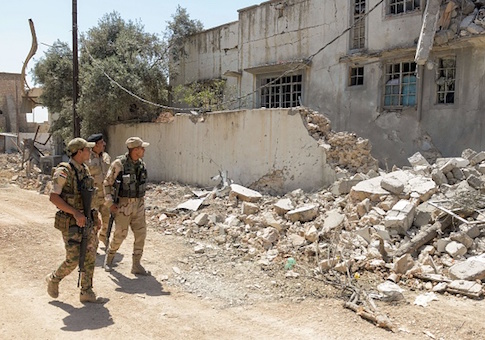The final days of ISIS in Mosul are now in sight, as the remaining terrorists try to take as many civilian lives as they can.
Only one small district in the Western part of the city remains under ISIS control, approximately 3 percent of the area of West Mosul. The fighting is now in the neighborhood of Al Shifa near the Tigris River, and next to it the so-called Old City, according to Major General Joseph Martin, the commander of the Combined Land Forces Component Command for Operation Inherent Resolve.
Iraqi Federal Police units are fighting house-to-house and through narrow streets and alleys where thousands of hapless civilians are locked inside to protect ISIS fighters from air strikes, according to Ali Sada, who publishes Daesh Daily, an anti-ISIS war digest. The Old City contains the grand mosque where Ibrahim Awad Al Baghdadi declared himself ISIS Caliph in June 29, 2014, and which today is believed to be a fortified bunker packed with terrorists and explosives. Baghdadi has not been seen or heard from in more than a year, and some observers believe he is either dead or severely wounded.
Prime Minister Haider Al Abadi said Wednesday that only two miles of territory are in ISIS hands. However, the remaining neighborhoods are littered with booby-trapped vehicles clogging the streets and house fronts containing improvised explosive devices (IEDs). The strategy of ISIS in previous urban battles of Ramadi and Fallujah in Al Anbar province is to force the recapture of territory to reduce the building stock to rubble, according to war observers.
The battle for Mosul, now in its eighth month, can be compared to the urban battles of World War II, Gen. Martin told reporters in a video call Thursday.
"I've never fought a fight like this in my life," Martin said. "I can tell you, I'd have to probably go back to World War II to talk about a fight that has been this size and this magnitude with the requirements that the Iraqis have imposed upon themselves, and chose to embark on this endeavor to liberate the people of this city."
The terrorist reserves of vehicle bombs and grenade-dropping drones are exhausted, according to Martin. ISIS holdouts are deploying machine guns, small arms, and a few anti-tank missiles. The Iraqi forces have demonstrated remarkable restraint in approaching the grand mosque for fear of causing the deaths of Iraqi civilians, Martin told reporters.
During the last four days, thousands of civilians have been able to run out of ISIS-controlled houses only to be shot down in the streets by ISIS snipers. The United Nations reported that on June 7 there were no fewer than 163 bodies of civilians lying in the streets in the neighborhoods of the conflict zone.
Gen. Martin credited the Iraqi Security forces with liberating a city "about the size of Philadelphia—200,000 buildings; 3,000 kilometers of road; 1.8 million people, and an adversary that could use them any way they like—slave labor, exploited population, sex slaves, whatever they want to do with them."
Gen. Martin declined to say how many terrorists remain in the Old City that is surrounded by Iraqi Security forces. On Tuesday the commander of Iraqi Federal Police told Iraqi media that his troops had captured 300 square km (117 square miles) since the start of the west Mosul Liberation operations in late January 2017, killing more than 1,000 Daesh terrorists and destroying 865 vehicle bombs, according to Sada, citing the same.
"Civil activists say that an airstrike [on Wednesday] left 50 civilians under the wreckage of a house in Borsa. The planes attacked a nearby house which caused the collapse of this house," reported Sada, citing Anadolu, the Turkish wire service. Coalition aircraft made a single strike in Mosul Wednesday, but it may not have been the strike causing this damage. Since the housing stock of the Old City is frail, housing collapses are common due to explosions.
After the fall of the Old City in Mosul, U.S. Coalition forces are expected to support ISF recapture of smaller cities which remain in ISIS hands, including the Tal Afar, 50 miles west of Mosul, the city of Hawijah, 30 miles southwest of Kirkuk, and several small cities on the Euphrates River as it passes the Iraqi Syrian border.
